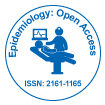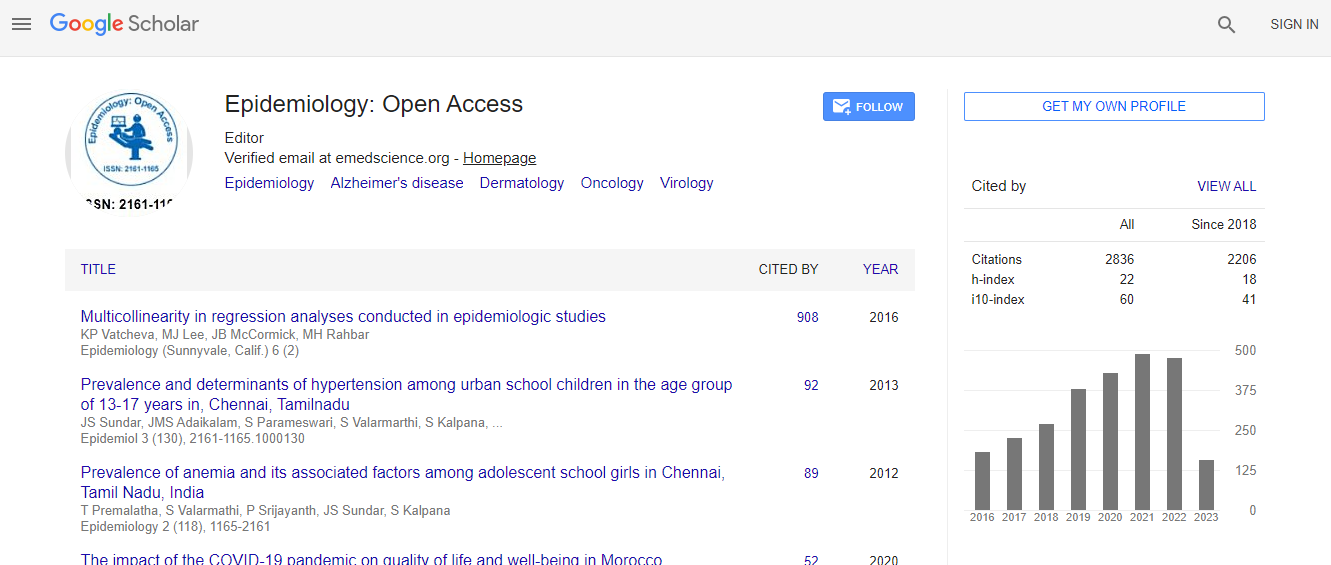Our Group organises 3000+ Global Conferenceseries Events every year across USA, Europe & Asia with support from 1000 more scientific Societies and Publishes 700+ Open Access Journals which contains over 50000 eminent personalities, reputed scientists as editorial board members.
Open Access Journals gaining more Readers and Citations
700 Journals and 15,000,000 Readers Each Journal is getting 25,000+ Readers
Google Scholar citation report
Citations : 3864
Epidemiology: Open Access received 3864 citations as per Google Scholar report
Epidemiology: Open Access peer review process verified at publons
Indexed In
- Index Copernicus
- Google Scholar
- Sherpa Romeo
- Genamics JournalSeek
- SafetyLit
- Access to Global Online Research in Agriculture (AGORA)
- Centre for Agriculture and Biosciences International (CABI)
- RefSeek
- Hamdard University
- EBSCO A-Z
- OCLC- WorldCat
- CABI full text
- Cab direct
- Publons
- Geneva Foundation for Medical Education and Research
- Euro Pub
- ICMJE
Useful Links
Recommended Journals
Related Subjects
Share This Page
Risk factors for American Tegumentary Leishmaniasis transmission in Equator, South America
International Conference on Epidemiology and Evolutionary Genetics
Gulnara Patricia Borja Cabrera, Jorge Quinchuelahidalgo, Lenin Gomez Barreno, Katherine Simbana Rivera, Diana Chavez Nunez, Wilian Caguano Caza, Ana Sanchez Yunga, Gabriela Robles Cordoba, Gisela Socasi Simbana, Jessica Gomez Valverde, Adriana Camacho Sanchez, Rosana Gomez Cerda, Jose Cedeno Rente
ScientificTracks Abstracts: Epidemiol
Abstract
I n Equator, American tegumentaryleishmaniasis (ATL) has been expanding to urban districts and little is known about the epidemiology. We investigated the profile of 1081 peoples from urban endemic districts, through epidemiologicalsurveyincluding assessment of attitudes, knowledge and practices (KAP) against the disease. The results showed that 15.7% suffered ATL, 41.4% were male, 52.2% female, 88.5% mulattos, 46% have only elementary school, 36.6% High school, 11.9% superior education, and only 3.3% were illiterates, 38.7% received only minimum wage, 22.1% less of minimum wage, and 52.8% are laborers. Respect to housing, 48.7% have cement and brick houses, with drinking water, sewerage and municipal garbage collection services in 73.4%, 64.4% and 86.7% of cases respectively. 87.4% have the presence of backyard,75.4% with earthen floor, 59.4% with shaded and 50.8% with moist. We identify the domestics animals predominantly dogs (56.4%) and chickens (37%). The animal waste is thrown into the yard(45.4%). Between 18 to 22 h, 87.7% of people stay indoors and 51.9% use insecticides.The Logistic univariate regression revealed that 70.4% of the interviewees have knowledge about Leishmaniasis (p= 0.000, OR= 0,221)and the not knowledge of preventions measures in 45.2% of cases shown to bea risk factor (p= 0.000; OR= 3.016). The knowledge of using insecticide inside house (p= 0.001; OR= 0,471) nets and awning (p= 0.000; OR= 0.471) could protect the people against ATL. Our results showed that Equator had a socioeconomic improvements but still a lack of knowledge of preventive measures against ATL.Biography
Gulnara Patricia Borja Cabrera is MD in Medicine, MSc, and PhD in Pathology at the UFF (Brazil) & Was Post Doc at UFRJand UFMG(Brazil). She was Professor at UFRJ from 2006-2010. She Was actively involved in the development of the first second-generation licensed vaccine against canine visceral leishmaniasis Leishmune? and a 3rd generation vaccine against the disease. Until 2012, She was Full time Professor at UNIVALE, Brazil and currently she is a Prometeo researcher in the National Secretary of Higher Education, Science, Technology and Innovation- Central University of Equator, Medical Sciences Faculty. She has published more than 21 papers in reputed journals.

 Spanish
Spanish  Chinese
Chinese  Russian
Russian  German
German  French
French  Japanese
Japanese  Portuguese
Portuguese  Hindi
Hindi 

